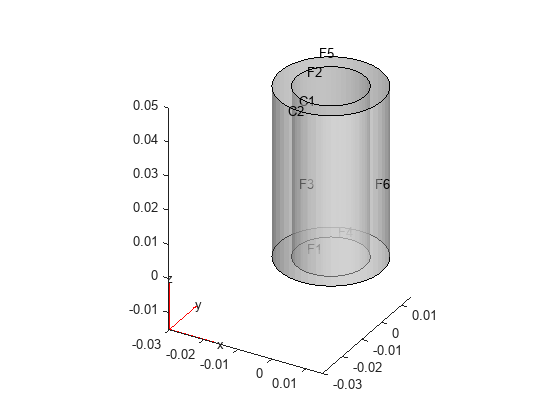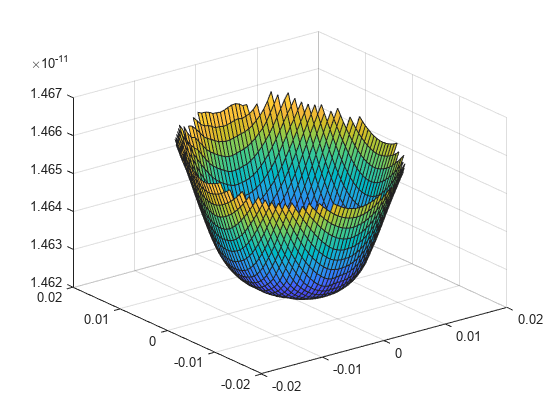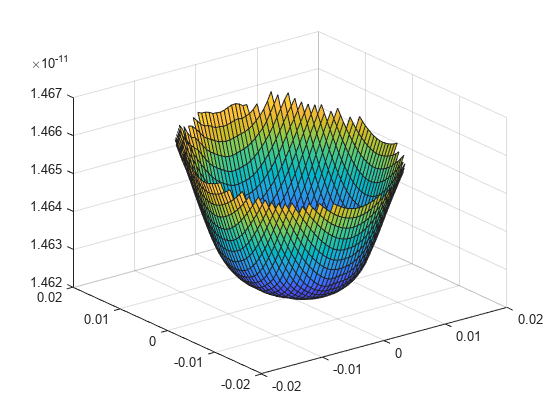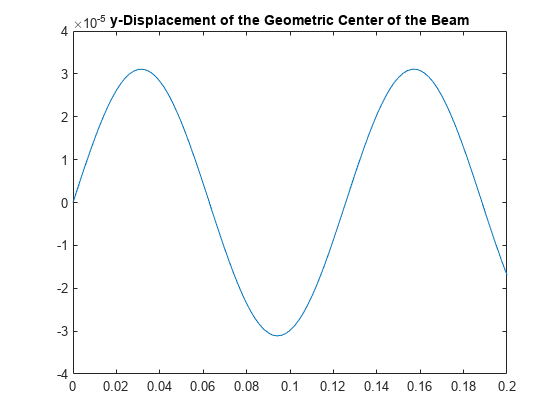interpolateDisplacement
Interpolate displacement at arbitrary spatial locations
Syntax
Description
intrpDisp = interpolateDisplacement(structuralresults,xq,yq)xq and yq. For transient and frequency
response structural problems, interpolateDisplacement returns the
interpolated displacement values for all time or frequency steps,
respectively.
intrpDisp = interpolateDisplacement(structuralresults,xq,yq,zq)xq, yq, and
zq.
intrpDisp = interpolateDisplacement(structuralresults,querypoints)querypoints.
Examples
Create an femodel object for static structural analysis and include a unit square geometry.
model = femodel(AnalysisType="structuralStatic", ... Geometry=@squareg);
Switch the type of the model to plane-strain.
model.PlanarType = "planeStrain";Plot the geometry.
pdegplot(model.Geometry,EdgeLabels="on")
xlim([-1.1 1.1])
ylim([-1.1 1.1])
Specify Young's modulus and Poisson's ratio.
model.MaterialProperties = ... materialProperties(PoissonsRatio=0.3, ... YoungsModulus=210E3);
Specify the x-component of the enforced displacement for edge 1.
model.EdgeBC(1) = edgeBC(XDisplacement=0.001);
Specify that edge 3 is a fixed boundary.
model.EdgeBC(3) = edgeBC(Constraint="fixed");Generate a mesh and solve the problem.
model = generateMesh(model); R = solve(model);
Create a grid and interpolate the x- and y-components of the displacement to the grid.
v = linspace(-1,1,21); [X,Y] = meshgrid(v); intrpDisp = interpolateDisplacement(R,X,Y);
Reshape the displacement components to the shape of the grid. Plot the displacement.
ux = reshape(intrpDisp.ux,size(X));
uy = reshape(intrpDisp.uy,size(Y));
quiver(X,Y,ux,uy)
axis equal
Analyze a bimetallic cable under tension, and interpolate the displacement on a cross-section of the cable.
Create and plot a geometry representing a bimetallic cable.
gm = multicylinder([0.01,0.015],0.05); pdegplot(gm,FaceLabels="on", ... CellLabels="on", ... FaceAlpha=0.5)

Create an femodel object for static structural analysis and include the geometry into the model.
model = femodel(AnalysisType="structuralStatic", ... Geometry=gm);
Specify Young's modulus and Poisson's ratio for each metal.
model.MaterialProperties(1) = ... materialProperties(YoungsModulus=110E9, ... PoissonsRatio=0.28); model.MaterialProperties(2) = ... materialProperties(YoungsModulus=210E9, ... PoissonsRatio=0.3);
Specify that faces 1 and 4 are fixed boundaries.
model.FaceBC([1 4]) = faceBC(Constraint="fixed");Specify the surface traction for faces 2 and 5.
model.FaceLoad([2 5]) = faceLoad(SurfaceTraction=[0;0;100]);
Generate a mesh and solve the problem.
model = generateMesh(model); R = solve(model)
R =
StaticStructuralResults with properties:
Displacement: [1×1 FEStruct]
Strain: [1×1 FEStruct]
Stress: [1×1 FEStruct]
VonMisesStress: [23098×1 double]
Mesh: [1×1 FEMesh]
Define coordinates of a midspan cross-section of the cable.
[X,Y] = meshgrid(linspace(-0.015,0.015,50)); Z = ones(size(X))*0.025;
Interpolate the displacement and plot the result.
intrpDisp = interpolateDisplacement(R,X,Y,Z); surf(X,Y,reshape(intrpDisp.uz,size(X)))

Alternatively, you can specify the grid by using a matrix of query points.
querypoints = [X(:),Y(:),Z(:)]'; intrpDisp = interpolateDisplacement(R,querypoints); surf(X,Y,reshape(intrpDisp.uz,size(X)))

Interpolate the displacement at the geometric center of a beam under a harmonic excitation.
Create and plot a beam geometry.
gm = multicuboid(0.06,0.005,0.01);
pdegplot(gm,FaceLabels="on",FaceAlpha=0.5)
view(50,20)
Create an femodel object for transient structural analysis and include the geometry into the model.
model = femodel(AnalysisType="structuralTransient", ... Geometry=gm);
Specify Young's modulus, Poisson's ratio, and the mass density of the material.
model.MaterialProperties = ... materialProperties(YoungsModulus=210E9, ... PoissonsRatio=0.3, ... MassDensity=7800);
Fix one end of the beam.
model.FaceBC(5) = faceBC(Constraint="fixed"); Apply a sinusoidal displacement along the y-direction on the end opposite the fixed end of the beam.
yDisplacementFunc = ...
@(location,state) ones(size(location.y))*1E-4*sin(50*state.time);
model.FaceBC(3) = faceBC(YDisplacement=yDisplacementFunc);Generate a mesh.
model = generateMesh(model,Hmax=0.01);
Specify the zero initial displacement and velocity.
model.CellIC = cellIC(Displacement=[0;0;0],Velocity=[0;0;0]);
Solve the problem.
tlist = 0:0.002:0.2; R = solve(model,tlist);
Interpolate the displacement at the geometric center of the beam.
coordsMidSpan = [0;0;0.005]; intrpDisp = interpolateDisplacement(R,coordsMidSpan);
Plot the y-component of displacement of the geometric center of the beam.
figure
plot(R.SolutionTimes,intrpDisp.uy)
title("y-Displacement of the Geometric Center of the Beam")
Input Arguments
Solution of the structural analysis problem, specified as a StaticStructuralResults, TransientStructuralResults, or FrequencyStructuralResults object. Create
structuralresults by using the solve function. For
TransientStructuralResults and
FrequencyStructuralResults objects,
interpolateDisplacement returns the interpolated
displacement values for all time and frequency steps, respectively.
x-coordinate query points, specified as a real array.
interpolateDisplacement evaluates the displacements
at the 2-D coordinate points [xq(i),yq(i)] or at the 3-D
coordinate points [xq(i),yq(i),zq(i)]. Therefore,
xq, yq, and (if present)
zq must have the same number of entries.
interpolateDisplacement converts query points to
column vectors xq(:), yq(:), and (if
present) zq(:). The function returns displacements as an
FEStruct object with the properties containing
vectors of the same size as these column vectors. To ensure that the
dimensions of the returned solution are consistent with the dimensions of
the original query points, use the reshape function. For
example, use intrpDisp =
reshape(intrpDisp.ux,size(xq)).
Data Types: double
y-coordinate query points, specified as a real array.
interpolateDisplacement evaluates the displacements
at the 2-D coordinate points [xq(i),yq(i)] or at the 3-D
coordinate points [xq(i),yq(i),zq(i)]. Therefore,
xq, yq, and (if present)
zq must have the same number of entries.
Internally, interpolateDisplacement converts query
points to the column vector yq(:).
Data Types: double
z-coordinate query points, specified as a real array.
interpolateDisplacement evaluates the displacements
at the 3-D coordinate points [xq(i),yq(i),zq(i)].
Therefore, xq, yq, and
zq must have the same number of entries. Internally,
interpolateDisplacement converts query points to
the column vector zq(:).
Data Types: double
Query points, specified as a real matrix with either two rows for 2-D
geometry or three rows for 3-D geometry. interpolateDisplacement evaluates the displacements at the
coordinate points querypoints(:,i), so each column of
querypoints contains exactly one 2-D or 3-D query
point.
Example: For 2-D geometry, querypoints = [0.5,0.5,0.75,0.75;
1,2,0,0.5]
Data Types: double
Output Arguments
Displacements at the query points, returned as an
FEStruct object with the properties representing
spatial components of displacement at the query points. For query points
that are outside the geometry, intrpDisp returns
NaN. Properties of an FEStruct
object are read-only.
Version History
Introduced in R2017bFor frequency response structural problems,
interpolateDisplacement interpolates displacement for all
frequency steps.
For transient structural problems, interpolateDisplacement
interpolates displacement for all time steps.
See Also
Objects
Functions
MATLAB Command
You clicked a link that corresponds to this MATLAB command:
Run the command by entering it in the MATLAB Command Window. Web browsers do not support MATLAB commands.
웹사이트 선택
번역된 콘텐츠를 보고 지역별 이벤트와 혜택을 살펴보려면 웹사이트를 선택하십시오. 현재 계신 지역에 따라 다음 웹사이트를 권장합니다:
또한 다음 목록에서 웹사이트를 선택하실 수도 있습니다.
사이트 성능 최적화 방법
최고의 사이트 성능을 위해 중국 사이트(중국어 또는 영어)를 선택하십시오. 현재 계신 지역에서는 다른 국가의 MathWorks 사이트 방문이 최적화되지 않았습니다.
미주
- América Latina (Español)
- Canada (English)
- United States (English)
유럽
- Belgium (English)
- Denmark (English)
- Deutschland (Deutsch)
- España (Español)
- Finland (English)
- France (Français)
- Ireland (English)
- Italia (Italiano)
- Luxembourg (English)
- Netherlands (English)
- Norway (English)
- Österreich (Deutsch)
- Portugal (English)
- Sweden (English)
- Switzerland
- United Kingdom (English)